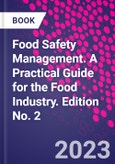Food Safety Management: A Practical Guide for the Food Industry, Second Edition continues to present a comprehensive, integrated and practical approach to the management of food safety throughout the production chain. While many books address specific aspects of food safety, no other book guides you through the various risks associated with each sector of the production process or alerts you to the measures needed to mitigate those risks. This new edition provides practical examples of incidents and their root causes, highlighting pitfalls in food safety management and providing key insights into different means for avoiding them.
Each section addresses its subject in terms of relevance and application to food safety and, where applicable, spoilage. The book covers all types of risks (e.g., microbial, chemical, physical) associated with each step of the food chain, making it an ideal resource.
Please Note: This is an On Demand product, delivery may take up to 11 working days after payment has been received.
Table of Contents
1. Food Safety Management: A Practical Guide for the Food Industry: The Story Behind the Book
2. Fundamentals in Management of Food Safety in the Industrial Setting: Challenges and Outlook of the 21st Century
3. Management of Safety in the Feed Chain
4. Naturally Occurring Contaminants and Inherent Toxicants of Plant Origin
5. Allergens
6. Milk and Dairy Products
7. Bakery and Farinaceous Products
8. Meat and Meat Products
9. Poultry Meat and Eggs
10. Seafood
11. Food Safety Management of Insect-Based Foods
12. Fruits and Vegetables (Including Herbs)
13. Coffee, Cocoa, and Derived Products (e.g., Chocolate)
14. Confectionery and Bakery Products; Including Honey
15. Edible Nuts, Oilseeds and Legumes
16. Vegetable Oils and Fats
17. Bottled and Drinking Water
18. Pet Food
19. Food Contact Materials
20. Thermal Treatment
21. Non-Thermal Processing Technologies
22. Acids and Fermentation
23. Chilling and Freezing
24. Detection of Physical Hazards
25. Principles and Systems for Quality and Food Safety Management
26. The Use of Big Data in Food Safety Management: Predicting Food Safety Risks Using Big Data and Artificial Intelligence
27. Hygiene in Primary Production
28. Principles of Hygienic Practice in Food Processing and Manufacturing
29. Site Selection, Site Layout, Building Design
30. Hygienic Design of Food Processing Equipment
31. Development of a Comprehensive Cleaning and Sanitizing Program for Food Production Facilities
32. Personal Hygiene and Food Worker Health
33. Pest Management
34. Safe Handling of Food in Homes and Food Services
35. Preventing and Managing Travel- Related Foodborne Disease
36. Hazard Analysis and Critical Control Point System (HACCP)
37. HACCP Misconceptions and Shortcomings
38. Detection of Microbiological Hazards
39. Management of Microbiological Hazards: Role of Testing as Verification
40. Management of Chemical Contaminants
41. Food Defense
42. Effective and Efficient Leadership
43. Human Factors in Food Safety Management
44. Assessment of Food Safety Management Systems
45. Incident Management and Root Cause Analysis
46. Crisis Management
47. Food Safety During Pandemics: A Focus on COVID-19
48. The Role of International, Regional, and National Organizations in the Development of Standards
49. Sustainability and Food Systems
50. Climate Change and Food Safety
51. Nutritional Trends and Health Claims
52. Consumer Information and Labeling
53. Misinformation About Food Safety
54. Ethics in Food Safety Management 1081
55. Whistleblowing: An Essential Element of Public Health and Food Safety Management
56. Training and Education








